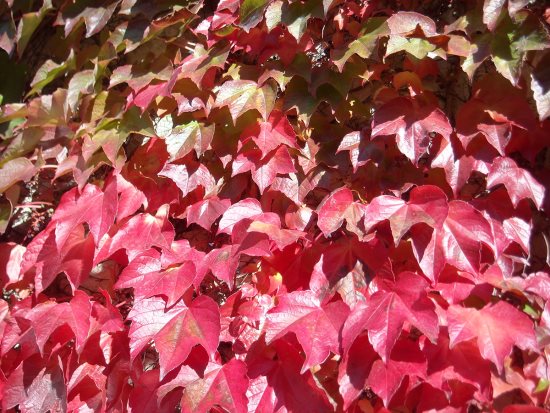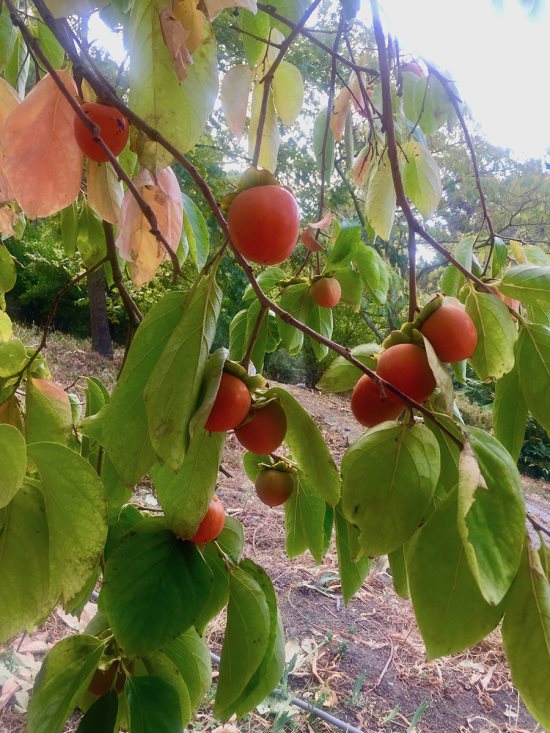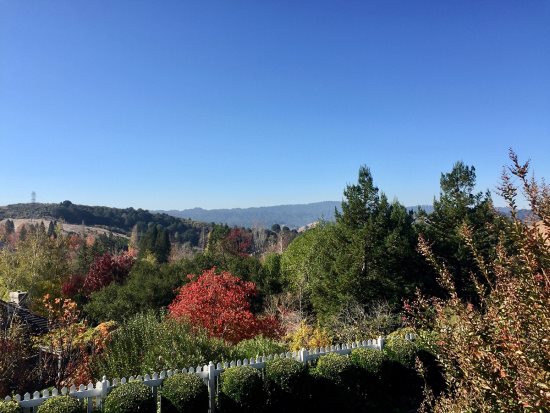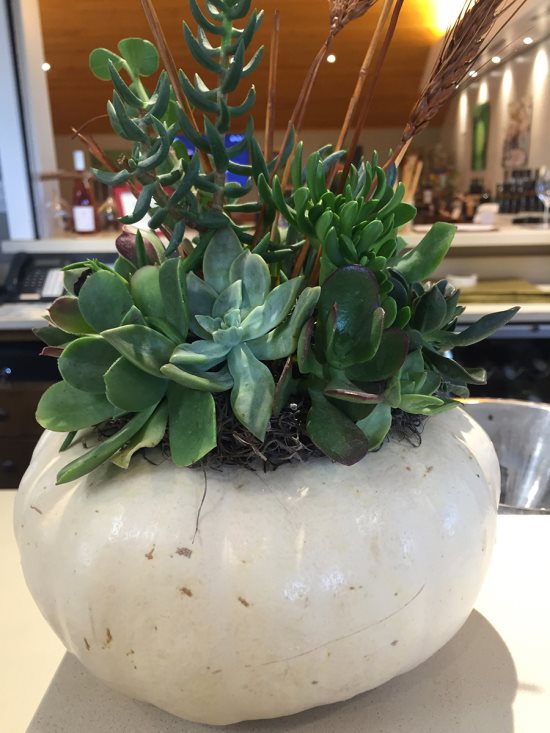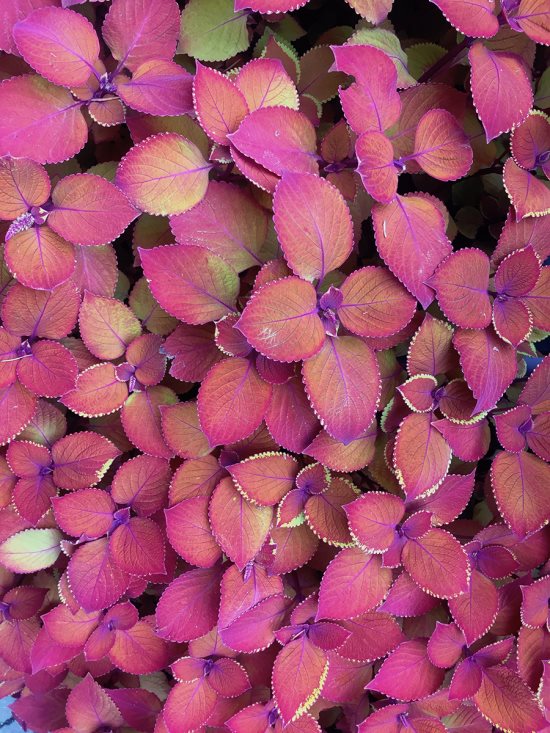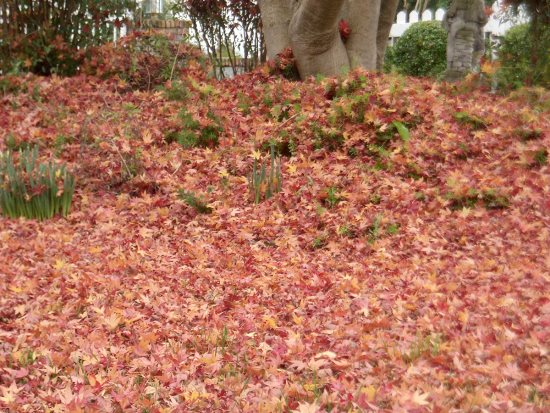 |
|
|
A thick pile of Japanese maple leaves blanket the garden. Photos Cynthia Brian
|
|
|
|
|
|
"Reflect upon your present blessings, of which every man has plenty; not on your past misfortunes, of which all men have some." - Charles Dickens, 1812-1870, Novelist
 Pumpkins, gourds, and scarecrows decorate our yards. Thanksgiving has arrived and we give thanks for our safety, the bounty on our tables, the flora in our curated gardens, our wide-open spaces, community camaraderie, and the benevolence of family and friends. Despite the electrical blackouts, evacuations and fires, for the most part, we have been spared despair and tragedy. As a gardener, I find solace, grace and gratitude while toiling in the dirt. I encourage you to discover happiness and joy in nature. Pay attention to the details. Walk around your home and journey into the garden to observe how your world is colored.
Pumpkins, gourds, and scarecrows decorate our yards. Thanksgiving has arrived and we give thanks for our safety, the bounty on our tables, the flora in our curated gardens, our wide-open spaces, community camaraderie, and the benevolence of family and friends. Despite the electrical blackouts, evacuations and fires, for the most part, we have been spared despair and tragedy. As a gardener, I find solace, grace and gratitude while toiling in the dirt. I encourage you to discover happiness and joy in nature. Pay attention to the details. Walk around your home and journey into the garden to observe how your world is colored.
 Begin by practicing gratitude for the simple things you take for granted: the bright red hues on the Boston Ivy, the intricate patterns on a coleus plant, the varied textures of a mosaic of palms, redwoods and liquid ambers swaying in the wind, a thick blanket of leaves fallen from the Japanese maple. What about being grateful that in normal times, we have electricity at the flick of a switch or warm running water by turning on a spigot? As frustrated as we are with our power company, we still luxuriate with more conveniences than people in many countries. We can't become numb to the delights and challenges of living.
Begin by practicing gratitude for the simple things you take for granted: the bright red hues on the Boston Ivy, the intricate patterns on a coleus plant, the varied textures of a mosaic of palms, redwoods and liquid ambers swaying in the wind, a thick blanket of leaves fallen from the Japanese maple. What about being grateful that in normal times, we have electricity at the flick of a switch or warm running water by turning on a spigot? As frustrated as we are with our power company, we still luxuriate with more conveniences than people in many countries. We can't become numb to the delights and challenges of living.
 The increased popularity of foraging has resulted in a stream of articles in magazines recently. Although I do advocate adding a variety of wild weeds to our diets, it is also important to caution the inexperienced about the dangers of picking plants that are unfamiliar. Whilst purslane, dandelions, amaranth and lambsquarters are highly nutritious, there are many botanicals that can trigger major allergies or even be deadly when consumed. Hemlock, which resembles wild carrots or Queen Anne's lace and oleander will kill humans and animals. Until you are knowledgeable about what you are gathering for your next supper, it's best to purchase your "exotic" greens from a Farmers' market or local vegetable bin.
The increased popularity of foraging has resulted in a stream of articles in magazines recently. Although I do advocate adding a variety of wild weeds to our diets, it is also important to caution the inexperienced about the dangers of picking plants that are unfamiliar. Whilst purslane, dandelions, amaranth and lambsquarters are highly nutritious, there are many botanicals that can trigger major allergies or even be deadly when consumed. Hemlock, which resembles wild carrots or Queen Anne's lace and oleander will kill humans and animals. Until you are knowledgeable about what you are gathering for your next supper, it's best to purchase your "exotic" greens from a Farmers' market or local vegetable bin.
 Persimmons appear like shiny orange ornaments hanging from tree limbs and will add a festive feeling to your holiday décor. Pick them now before the squirrels and birds add them to their autumn menu. Persimmons will ripen on the counter. Keep in mind that astringent Hachiya persimmons must be soft before eating, while the Fuyus are most delicious and perfect for lunch snacks or sliced into salads when hard and crunchy like apples.
Persimmons appear like shiny orange ornaments hanging from tree limbs and will add a festive feeling to your holiday décor. Pick them now before the squirrels and birds add them to their autumn menu. Persimmons will ripen on the counter. Keep in mind that astringent Hachiya persimmons must be soft before eating, while the Fuyus are most delicious and perfect for lunch snacks or sliced into salads when hard and crunchy like apples.
 November is usually the optimum month to plant trees, bulbs, transplants and seedlings, however, without any rain this autumn thus far, I am recommending waiting until we have at least a day of consistent moisture. Even though I watered boxwoods and annuals purchased earlier in the month, these plants are struggling and will probably have to be replaced.
November is usually the optimum month to plant trees, bulbs, transplants and seedlings, however, without any rain this autumn thus far, I am recommending waiting until we have at least a day of consistent moisture. Even though I watered boxwoods and annuals purchased earlier in the month, these plants are struggling and will probably have to be replaced.
 As we celebrate November, we prepare for the dormant season ahead. Hopefully, we'll experience much-needed rainfall soon.
As we celebrate November, we prepare for the dormant season ahead. Hopefully, we'll experience much-needed rainfall soon.

 Cynthia Brian's Gardening Guide for end of November
Cynthia Brian's Gardening Guide for end of November
 - CLEAN UP any leaves or weeds remaining from annuals and vegetables. Compost your healthy debris. Cleaning up now will prevent the population of snails, earwigs, and sowbugs from expanding.
- CLEAN UP any leaves or weeds remaining from annuals and vegetables. Compost your healthy debris. Cleaning up now will prevent the population of snails, earwigs, and sowbugs from expanding.
 - WATER ornamentals and perennials that have withered from the dry winds.
- WATER ornamentals and perennials that have withered from the dry winds.
 - PRUNE shrubs before new flower bulbs form. As soon as crape myrtles lose their leaves, shape your trees. Prune fig trees to a size to keep the fruit within reach.
- PRUNE shrubs before new flower bulbs form. As soon as crape myrtles lose their leaves, shape your trees. Prune fig trees to a size to keep the fruit within reach.
 - CUT back leggy geraniums and pelargoniums. New growth with an abundance of flowers will re-emerge by spring.
- CUT back leggy geraniums and pelargoniums. New growth with an abundance of flowers will re-emerge by spring.
 - FORAGE only for plants that you can positively identify.
- FORAGE only for plants that you can positively identify.
 - FERTILIZE your hedges with fertilizers high in nitrogen. Lawns need their second feeding application now. Water deeply.
- FERTILIZE your hedges with fertilizers high in nitrogen. Lawns need their second feeding application now. Water deeply.
 - RAKE fallen leaves to add to the compost pile.
- RAKE fallen leaves to add to the compost pile.
 - CLEAN rain gutters of leaves and add to your compost pile.
- CLEAN rain gutters of leaves and add to your compost pile.
 - SPRAY deciduous fruit trees with dormant oil. Pears, peaches, plums and apricots will benefit from three rounds of spraying, usually toward the end of November, December and January.
- SPRAY deciduous fruit trees with dormant oil. Pears, peaches, plums and apricots will benefit from three rounds of spraying, usually toward the end of November, December and January.
 - PERUSE nurseries for perennials such as columbine, carnations, coral bells, and chrysanthemums which can be planted from six-packs as soon as it rains.
- PERUSE nurseries for perennials such as columbine, carnations, coral bells, and chrysanthemums which can be planted from six-packs as soon as it rains.
 - DEADHEAD your roses regularly to maintain blossoms and fragrance until January. If you prefer, allow the rose hips to grace your bushes with their vibrant red and orange color. Pick the hips to add vitamin C to your tea.
- DEADHEAD your roses regularly to maintain blossoms and fragrance until January. If you prefer, allow the rose hips to grace your bushes with their vibrant red and orange color. Pick the hips to add vitamin C to your tea.
 - DIVIDE perennials and separate overgrown clumps. Plant elsewhere or share extras with a friend.
- DIVIDE perennials and separate overgrown clumps. Plant elsewhere or share extras with a friend.
 - COLLECT dried grasses, pods, willows, branches and other natural materials for a cornucopia of autumn arrangements.
- COLLECT dried grasses, pods, willows, branches and other natural materials for a cornucopia of autumn arrangements.
 - HOLLOW out a pumpkin or gourd and plant with succulents for an appealing Thanksgiving display.
- HOLLOW out a pumpkin or gourd and plant with succulents for an appealing Thanksgiving display.
 - CREATE glorious fall hued floral arrangements with the firecracker colors of roses, gerbera, berries and reeds.
- CREATE glorious fall hued floral arrangements with the firecracker colors of roses, gerbera, berries and reeds.
 - VEGETABLES such as broccoli, beets, carrots, lettuce, peas, turnips and spinach can be planted by seed when carefully watered.
- VEGETABLES such as broccoli, beets, carrots, lettuce, peas, turnips and spinach can be planted by seed when carefully watered.
 - HARVEST your pumpkins, gourds, squash, apples, walnuts, persimmons and tangerines. Create a basket of edibles as festive holiday décor.
- HARVEST your pumpkins, gourds, squash, apples, walnuts, persimmons and tangerines. Create a basket of edibles as festive holiday décor.
 - ENJOY the fall foliage and views of the changing tree colors from a hilltop location.
- ENJOY the fall foliage and views of the changing tree colors from a hilltop location.
 - BE grateful for your garden. Whether your plot is large, medium or small, or even if you only showcase a potted plant in the window, you are a gardener. Keep digging. Grace and gratitude are buried in the dirt. Everyone grows with nature.
- BE grateful for your garden. Whether your plot is large, medium or small, or even if you only showcase a potted plant in the window, you are a gardener. Keep digging. Grace and gratitude are buried in the dirt. Everyone grows with nature.
 Take time to give thanks for the little things every day, not just once a year. Be grateful for what you have. Having an attitude of gratitude makes every moment shine brightly.
Take time to give thanks for the little things every day, not just once a year. Be grateful for what you have. Having an attitude of gratitude makes every moment shine brightly.
 Each day is Thanksgiving Day when you live, learn, laugh, love, and appreciate what you have. Share the abundance.
Each day is Thanksgiving Day when you live, learn, laugh, love, and appreciate what you have. Share the abundance.
 Wishing everyone a very happy, healthy, and delicious Turkey Day!
Wishing everyone a very happy, healthy, and delicious Turkey Day!
 Happy gardening. Happy growing. Happy Thanksgiving!
Happy gardening. Happy growing. Happy Thanksgiving!
 "Gratitude is riches. Complaint is poverty." Doris Day
"Gratitude is riches. Complaint is poverty." Doris Day
|

